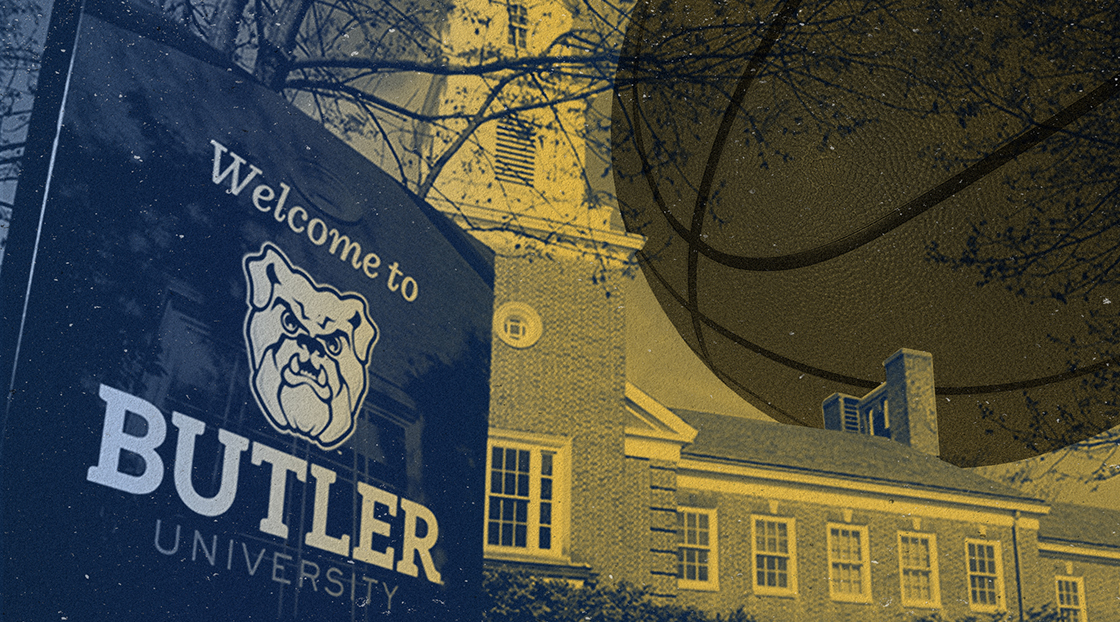Overview
In the late 1980s, Butler was a respected regional institution without a reputation for athletic prowess. So when the school decided to tap into its Hoosier roots and invest heavily in the men’s basketball program, success was far from guaranteed.
But that investment did pay off, both figuratively and literally. The Bulldogs made a string of March Madness appearances in the late 1990s through the 2000s, then improbable back-to-back appearances in the national championship, in 2010 and 2011. The rise of the Bulldogs to the national spotlight as lovable, bracket-busting underdogs elevated the school’s visibility, paying off quite literally with an estimated $1 billion earned media valuation from those back-to-back runs.
Meanwhile, the school’s endowment has grown by $100 million, nearly doubling, and annual giving has grown both from alumni and from people without ties to the university – including a $25 million gift in 2016 from a family that didn’t attend the school, and whose children didn’t either; Honaker says they just liked the school’s values and trajectory.
The resultant Flutie effect has seen applications double over the past decade, growth that has continued even during COVID-19, in part because the swell in applications has made Butler a more competitive institution, Honaker says. But while enrollment has grown from 4,100 to 4,700 since the school’s Final Four appearances, Honaker says the school won’t grow past 5,000.
“Then you start compromising who you are,” he says. “We take pride in being a small intimate [school], small classroom setting.”
Butler has not had a strong season this year, but in case you wonder who Honaker is picking to go all the way this year, he still chooses the Bulldogs. Of Gonzaga.
Read a complete transcript of the interview
Heather Dotchel:
Hello and welcome to Higher Voltage. Our podcast explores the ins and outs of higher education marketing and touches on all aspects of the business of higher education. My name is Heather Dotchel. I’m a Philadelphia-based marketing and communication professional, who most recently led the marcom divisions at two area colleges.
Heather Dotchel:
Today, we are speaking with Graham Honaker, Executive Director of Principal Gifts for University Advancement at Butler University. He also authored The Cinderella Strategy: The Game Plan behind Butler University’s Rise to Prominence, a chronicle of Butler’s purposeful decision to center its identity on basketball and the boost in national visibility and enrollment that it saw as a result. Graham, can you tell us a bit about your background and what prompted you to write this book?
Graham Honaker:
Yes. First of all, thank you, Heather, for having me. It’s a real honor to be on today. My background, I’ve been in higher education most of my career. I’m in my ninth year at Butler University on the principal gifts, major gifts side. The rationale behind the book, we can talk more about it, but Butler hit lightning in a bottle by going to back-to-back Final Fours in men’s basketball in 2010, 2011. And in my work here in the past decade, I kept seeing these transformational gains in facilities, fundraising, endowment growth, move to the Big East Conference, and particularly in enrollment and application growth. I thought, I’m biased, but this is a really unique story and I think a really optimistic story of a small, relatively, two decades, three decades ago, unknown small school in the Midwest that had really risen in profile.
Graham Honaker:
I had a dream of writing a book, and I started capturing some of the stories, if nothing else, from my own personal memories. When COVID hit last year, I, along with my coauthor, Jerry Logan, I called him and said, “I have a little more time on my hands. Do you want to dive into this concept more?” He had done his dissertation on the notion of athletic success and its impact on a university. And we just started cranking. We started cranking every day and came up with a manuscript, and really pleased that the book is going to be published in March.
Heather Dotchel:
Before we jump into questions, let me say that Higher Voltage is brought to you by Salesforce. Today’s higher ed marketers are faced with new challenges and must expand beyond their traditional tactics to engage with constituents. Learn how Salesforce empowers institutions of all sizes to unify first party data, build and measure targeted campaigns, and deliver personalized messaging across channels. Visit salesforce.org to learn more about how Salesforce can help your institution meet its goals.
Heather Dotchel:
So let’s dive into this. Let me say, as someone who was faculty before I was in marketing, I’m a bit of a skeptic for this approach, and I’m hoping that you convince me of its integrity as well as its effectiveness. Give us a little background about Butler. What’s its overall status, the brand marketing efforts were prior to its investment in the basketball program as an institutional strategy?
Graham Honaker:
Well again, we were relatively unheard-of outside of the Midwest in the ’70s, ’80s, ’90s, even early 2000s. In 1989 our president at the time, Geoff Bannister, got together with our new basketball coach, Barry Collier, who’s currently the athletic director, and said, “You know, we’re in Indiana. That’s a state that loves basketball. Basketball is basically a religion here. We have this unique resource in Hinkle Fieldhouse, which is one of the iconic gymnasiums in the country. It’s where the final scenes for the movie Hoosiers was held. Why don’t we put some eggs into men’s basketball?” Which ironically a few years before, they were thinking, should we jump out of Division One? And started building that strategy. Again, in the 1990s, late 1990s, we went to the NCAA Tournament for the first time since the early 1960s, consistently were an NCAA Tournament player.
Graham Honaker:
And then as you said, there is a bit of a risk, and we hit the lottery by going to the Final Four. And then I’d say we hit the Powerball by going back again in 2011. We can talk more about the impact over the past decade, but we’re very fortunate that we find ourselves in really good standing, particularly with the pandemic. We just enrolled our third largest class ever this past fall at a time, as I’m sure you’re aware, even before the pandemic, when applications were declining, enrollments were declining, particularly a really hard time for small private liberal arts schools like we are.
Graham Honaker:
I would say our marketing efforts were mediocre at best prior to those Final Fours, so we really worked at leveraging the story, the story of this strategy, the story of the Final Fours. And really those final fours simply provided a front porch effect. We had great things going on here, solid academics, strong faculty and students, but those opened up the front porch for us. Our president, Jim Danko, came in, he came from Villanova from your home there in Philadelphia, which is a school that had really done this well in terms of leveraging athletic success, and he said, “We have a limited window where we can brand and tell this story.” And we started doing that. We started aggressively getting our story out there, working even harder than we did before the Final Fours to share the message.
Heather Dotchel:
So was it purely the success that you were having with the basketball team that prompted this, or had there been rumblings of an athletics swerve in strategy that had been happening prior?
Graham Honaker:
Well, we did put a lot of eggs again into men’s basketball. We appreciate all of our sports here. That was the visible one for us. And we used that tale of the Final Fours to really tell a broader story, tell a story of, again, a strong academic school that just had not gotten perhaps its due attention because we’re in a crowded educational marketplace here in Indiana with IU, Purdue, Notre Dame. So it allowed us a bit more of a platform to tell that story and to move forward with sharing, perhaps, lessons that maybe some other schools in our sphere could maybe replicate.
Heather Dotchel:
So you’re saying this is the platform to tell stories of academics, but why not put resources into academic stories and outcome stories? And where did these resources come from? It’s not inexpensive to be in Division One and to be a contender and stay there.
Graham Honaker:
That’s a great question. In the decade since, we really have gotten those academic stories out. As far as the funding, that athletic success has had a huge impact on being able to fund the academic side of the university. Again, our endowment grew $100 million over the last decade. It almost doubled, actually, providing more opportunities for scholarships. We had three of the largest fundraising years in our history, which obviously helped funnel more resources into the university. We had our largest gift ever in 2016, a $25 million gift from a family who had a bit of a tenuous tie to Butler. They didn’t attend the school, their children didn’t attend the school, and part of their inspiration for the gift was the trajectory of Butler. They were really proud of where the university had gone, and the values of the university aligned with theirs.
Graham Honaker:
So the athletic impact from a resource standpoint has allowed us to put a lot more money into the university. And we also have tales of so many talented students coming here because Butler was better known on the East Coast than on the West Coast. We have stories in the book of faculty members, a faculty member from Iran, a really talented entrepreneurship professor, who Butler came on his radar because of the basketball program. So I’d say it’s the catalytic effect of the basketball program spilling over into the academic side, and since then really trying to hone in on marketing some of the academic successes of the university.
Heather Dotchel:
And that makes sense to me as kind of a juggernaut got underway. Success tends to beget success. But what about at the beginning when this changeover made? I have to imagine that you got pushback from your campus constituents, from faculty, and all of that, for switching the focus to basketball. How did you navigate that? How did you encourage buy-in? Is everybody on board at this point? Tell me a little bit more about that journey.
Graham Honaker:
That is an excellent question and leads me to believe you’re very familiar with the faculty-athletics dynamic on a campus. I wasn’t here in 1989, so I can’t speak from personal experience, but from some of our interviews, there was a lot of skepticism. We had a faculty member who is still here and quoted that a lot of the faculty members at the time laughed, because Butler had had very little success basketball-wise for a couple of decades, and thinking, what are we doing here? Why are we doing this?
Graham Honaker:
As the program succeeded, I think you got more buy-in. One of the lessons, we’ve got about 14 principles in the book that again we hope organizations might be able to glean something from, so you have to have a collective acceptance of change. The Final Fours were great, but there was massive change. We were now moving from the Horizon League Conference to the Big East, so now competing with the Georgetowns and the Villanovas of the world. So that’s a big change. Expectations in terms of fundraising, marketing, publicity, and for the faculty themselves, course loads. Now that the enrollment goes up, they’ve got more students, they’ve got more class loads, those type of things.
Graham Honaker:
I’d say by and large, there has been that collective acceptance. Certainly not 100%, but I think even now some of the skeptics who we quote have seen what that athletic success has done for the university in terms of that funding mechanism, in terms of the enrollment growth. Again, our applications have doubled over the last decade. I think they’ve seen some of the benefits that men’s basketball and athletics has given us. So I don’t think you’re ever going to get 100%, but I do think we’ve come a long way from that buy-in.
Heather Dotchel:
Sure, but I am going to push a little bit here, because one of the things that we really try to do with our podcast is to give takeaway tactics for our audience, because we all have different experiences and it’s great to share, like I did this and it really helped me accomplish that, because most things are scalable for all of our different institutions. Going into this strategy change, if you realize there’s going to be that kind of pushback on campus, what kind of things did marketing and comm and the other service groups on campus do, advancement, for example, to help ease that transition?
Graham Honaker:
I think the first thing, Heather, we had a real strong conviction that we were not going to lose our identity in the process, that even though there were these big changes, we’re going to stick to our core values. Even with the enrollment growth, we were about 4,100 students in 2010, we’re now at 4,700, we still maintain that we’re not going to go beyond 5,000 students. I’m not sure anytime soon we’ll go beyond 4,800, because then you start compromising who you are. We take pride in being a small, intimate, small classroom setting, and we wanted to really push that message.
Graham Honaker:
We’re changing in some ways, but we’re not going to change who we are. We could talk more about it, but The Butler Way brand, this creed that we live by of humility, team above self, passion, unity, that message was really stressed by marketing and communications, not just externally but internally. We want to stay true to those values. So I think pushing that conviction of we’re growing, but we want to grow and not change our personality in the process.
Heather Dotchel:
Got it. All right. One more little bit follow-up question to that, and then I’ll let you off the hook with this line of questioning, but were there any doubts or concerns along the way that it wasn’t working?
Graham Honaker:
I think so. When we first entered the Big East, our athletic teams struggled. We’re still not top dog in the Big East, although we’ve won some championships. There’s still some skepticism that can we really compete in this league? There was certainly skepticism when we were looking to completely overhaul our facilities. My lead project was the new building for the Lacy School of Business, which was a $50 million project. That was like going to the moon for us in fundraising. And you had a lot of long-time faculty, staff that chuckled at that number, that boy, they’re not going to come close. Even consultants we hired, we did a massive campaign to renovate Hinkle Field House, which really hadn’t been touched in decades. As a matter of fact, when they filmed Hoosiers here in 1986, they said, “We really don’t need to do anything here,” that the story was based on the team in the early 1950s, because Hinkle still looked like that.
Graham Honaker:
But we had a consultant come in and said, “You’ll be lucky to raise $12 million for this project, given your past history.” It was a $35 million goal. We actually doubled what the consultant said. So there was a lot of doubt on what we can do from a fundraising standpoint. There was, and still is, doubt that we can compete athletically in the Big East. And yeah, you’re always going to have your skeptics, and they certainly still exist. But I think, again, by and large had a unified front. We’d been an underdog for decades, we’re still a bit of an underdog, and so there’s still that underdog spirit that we can, we can compete at this level academically and athletically.
Heather Dotchel:
Okay. Let’s pivot a little bit, to use a basketball term and one we’ve used way too many times in the pandemic and is kind of a running joke on this program. Let’s pivot to talk a bit about the trajectory of success. You wrote that the school saw a jump in applications and enrollment after the back-to-back Final Four appearances in 2010 and 2011, but you had been making investment in this program for well over a decade at that point. So was it a case of having a decade of really lean years where you weren’t sure this was going to work and then once that happened, it took off, or was there steady increase that might’ve been invisible up to that point? How did that chart look, if you were to take a look at investment and return on investment of this change of strategy?
Graham Honaker:
Again, I think we had done a really mediocre job in the years prior to 2010, and I’m not trying to make that a personal criticism. But again, we hit the Powerball with those back-to-back Final Fours. Our president came in and said, this was a direct quote and it’s in our book, “You got to go big or go home now, in really, really getting out there, marketing, being really aggressive, and using this to boost what we’re doing. Specifically, having an application and enrollment strategy.”
Graham Honaker:
But the big piece, Heather, and this may be more sustainable than the Final Fours themselves, was the invitation to the Big East Conference. For our listeners, if you’re not familiar, the Big East Conference is comprised of 11 schools, Villanova, Providence, Marquette, Georgetown, Connecticut, not just great basketball institutions but good academic schools. But what that allowed for us to do is now we’re in these markets. We’re in DC, we’re in New York, we’re in Philadelphia consistently. And that name recognition is really going up. Well, that impacts, obviously, your applications. So again, we saw massive, I think a 44% increase in the year after those two Final Fours.
Graham Honaker:
The other interesting thing is, back in 2010, the demographic for our students was 60% in-state, 40% out-of-state. It’s completely flipped. So that national notoriety, not just the Final Fours, but being invited to join the Big East Conference, which would not have happened without the two back-to-back Final Fours, would not have allowed for more of those markets to open up, particularly in the Northeast, where we’re seeing not only an influx of students coming but also major gift donors from those areas as well.
Graham Honaker:
And then strategically, Chicago had always been a big hub for us. Now we deployed a full-time admissions officer to DC after that move to the Big East. So there was really a lot of thought, a lot of strategy. But to your initial question, the catalytic bump came after those two Final Fours, in enrollment and applications.
Heather Dotchel:
Yeah. That’s quite a catalytic bump. I think any time we see as institutions something that is viral, and let’s use that in the broadest kind of way, not social media viral, but just any kind of exposure that goes beyond anything that we’ve had before, there’s a huge, huge value, like dollars and cents value, that you can assign to that. So back-to-back Final Four appearances, billion dollar earned media evaluation. We can talk soft numbers here, but what are the implications for Butler with all of a sudden having this land in your lap?
Graham Honaker:
Yeah. We actually had a group called the Borshoff Media Group estimate the value of the two back-to-back Final Fours, and they came up with $1.2 billion, billion with a B, of what that meant in terms of earned media attention. There’ve been a couple other numbers floated out there, $1 billion, maybe $800 million, $1.1. I think no matter which number you look at, it’s huge, right? It’s a huge number. But in addition to that, we got a really nice bump from the stories that were coming out of it.
Graham Honaker:
There’s a famous story I don’t know if you’re aware of, but in 2010, fortunately the National Championship Game was played here in Indianapolis, and our players went to class the day of the game, which was crazy. There were people who didn’t believe it. CNN actually questioned it, called our president, and he said, “Come to campus if you want to see it.” But that story was told over and over and over again, so not only did you have this massive media bump, you had a really positive story there, that particularly in a time when there’s skepticism amongst college athletics, that players just come, they’re basically rent-a-players or mercenaries that come and they don’t really go to class, well gosh, you saw the school that, wow, these guys went to class the day of the game. And since then, that story is still told. And our men’s basketball players graduate, have a very high graduation rate. I’m rambling a bit here, but you had this huge bump, but also a positive story to go along with it.
Heather Dotchel:
Yeah, that’s a great placement. Let’s talk a little bit more about what this has done for the university profile. Your enrollment increased, as you mentioned, quite a bit, but you’re saying that you’re capping it a little bit, the number of students that will come in. So is this making Butler a more competitive school academically?
Graham Honaker:
Yeah. And we actually track that in the book. We did some research, and this is true of some other schools. Boston College, there’s something called the Flutie effect, Doug Flutie. There was a huge upset in 1984 where he threw a miracle pass and they beat Miami, and they tracked it and they found the applications not only went up, but so did GPA scores and SAT scores. And we’ve seen that here too. We’ve seen hikes, I think a 100-point hike in SAT scores, increases in GPA. So not only are you getting more applications, you’re getting a better pool of students from that standpoint.
Heather Dotchel:
What about for philanthropy? How did that get affected? I’m assuming there was some significant effect there.
Graham Honaker:
Tremendous, and that was probably my number one inspiration in starting to write the book, because I had seen this. I had been on the front lines and seen it. We mentioned the $100 million jump in endowment, three best fundraising years we’ve had, largest gift we’ve had. But to break it down even further, in the five years after those two Final Fours, you saw a gradual increase. We averaged $16 million a year in philanthropy. In the five years since, we’ve averaged $36 million. And there are many, many tales in the book about donors coming on board because they were proud of where the university had come.
Graham Honaker:
A couple of examples. We had a couple who lives in Lexington, Kentucky, and he was a 1970 graduate. They had not been involved at all at the university. And they came forward after 2011 and said, “We don’t have children. We want to leave $2 million to you in our estate plan.” And they basically attributed that to their pride in the Final Four. We’ve had $9 million gifts in recent years come from non-Butler alumni, I think people who really got pulled into the Butler story. So philanthropy has been just completely transformed. I’ve certainly benefited from it, and our division as well.
Heather Dotchel:
When you were setting out with this strategy, were there other small schools or schools that weren’t athletic powerhouses that you were emulating, a model that you were following?
Graham Honaker:
There’ve been a number since. George Mason really was the first true underdog to make the Final Four. They made it in 2006. So we did take some lessons there. The biggest one was actually Duke. Now, everybody knows Duke as a powerhouse now, and ironically, they were the team we played in 2010. But if you go back to the early ’80s, they were not a powerhouse. Mike Krzyzewski developed a strong brand. They started winning big. And if you go back to their applications, academic trajectory really started to go up quite a bit then.
Graham Honaker:
Well, after 2010, a group of administrators from Butler visited Duke and spent a day there and asked them questions about, if you were in our shoes, you were in our shoes, what should we be doing right now? So I guess dialing back, we took an example that had a couple decades of history. Since Butler, though, you’ve seen other schools, Virginia Commonwealth, Loyola of Chicago, and I think there’ll be more of them. But there weren’t too many Butlers before Butler. And then I guess the other one would be Gonzaga, a close parallel as well. I have some colleagues that I lean over there, and I constantly pick their brain for what are you doing? How are you doing in this area to leverage what you’re doing on the basketball court?
Heather Dotchel:
So what lessons from this that you all have learned can smaller schools, smaller than Butler, because there are some, learn and potentially emulate?
Graham Honaker:
I think the first one is patience. We built that strategy in the late ’80s. It did not immediately pay dividends. And I think the patience doesn’t have to necessarily translate to a decision to invest in athletics. It can be another move, to perhaps invest heavily in online education or whatever that may be. Most likely, you’re not going to see immediate results from that, but I think you’ve got to be patient. I think patience has been a big key in terms of it’s really been a 30-year arc for us to get where we are now.
Graham Honaker:
I think another one is hiring culture, and hiring culture I translate to a lot of different areas of the campus, but probably prominently would be our basketball coaches. We’ve actually had six coaches since 1989. All of them have been hired from within. They either played here at Butler or they coached or they were an assistant coach here. And what’s worked there is they really understood the culture. They understood who Butler was, what Butler stood for. Again, we didn’t want to sacrifice our brand. We didn’t want to just win games and lose players not graduating, not going to class. So I think hiring culture, certainly you’re never going to hire all from within, but even people that you bring in from the outside have to understand who you are as an institution, where you’re going, what your strategic plan is.
Graham Honaker:
I mentioned before a collective acceptance of change. If you’re really going to make a transformational change, you’ve got to get buy-in. You’ll never get 100%, but your messaging internally, your listening to concerns, the fears about changing, is very important. And we do offer a contrast in the book. I have great respect for what he does up at Purdue, but Mitch Daniels, three, four years ago, they decided to purchase Kaplan, and they really didn’t engage their faculty probably to the extent that they should have. They had a lot of dissent about that decision, and they still do. I’ve got friends up there that still do. So the bottom line, when you make massive change, you’ve got to work on getting collective buy-in from your staff and your faculty. I think those would be a couple that stand out for me.
Heather Dotchel:
So what’s next? You talk in the book about losing the head coach that got you there, and yet the program continues to succeed. How do you cope, though, if you fall from prominence?
Graham Honaker:
Great question. I joke that our coaches have done so well here that we continue to have other schools that pick them off. This question was asked to me the other day in another interview. I think the biggest fear we have would be losing our brand. We certainly want to win games. We want to compete at a high level in the Big East. We don’t want to lose ourselves in the process.
Graham Honaker:
Right now if you’re a basketball fan, you’ve seen a lot of the blue bloods really struggling this year. I won’t mention them by name, but there’s one in particular where they’re really struggling on the court, and their alumni base is just irate. They’re up in arms. They want the coach gone. Here, I don’t think you would have that to that extent, because there is this appreciation of the academic and the athletic side being both in the limelight, with a collective goal from our fan base. They also don’t want us to sacrifice who we are.
Graham Honaker:
You know, if we get really bad in basketball, I’m confident that fortunately over the last 10 years, we’ve really put ourselves in position to stay strong as an institution, with our application trend, with really transforming the campus with the right facilities, not just academic buildings, but residence halls, to keep us strong. So I think, again, we’re really fortunate for those years of 2010, 2011, to build upon them, to be where we are now. And you look back at those Final Fours with a nostalgia and pride, but there’s one alum who put it really well when he said, “You now look back with a little bit of relief that those happened,” and it put us in a position to weather the pandemic and hopefully to weather times when we’re not very good in basketball.
Heather Dotchel:
I appreciate you talking about the importance of brand overall to this. Tangential question, where does marketing and communications report to in your organizational structure?
Graham Honaker:
They report to the vice president for marketing innovation, who sits on the president’s cabinet.
Heather Dotchel:
Okay. And how closely does advancement work with the marketing and comm team? There’s so much crossover in messaging here, I’m just curious.
Graham Honaker:
Very closely. As a matter of fact, this morning I was on the phone with a representative from marketing, talking about a donor who’s just made a $2 million commitment that we’re going to highlight. We’re going to get that out as a press release. But we’ve worked hand in hand. We’re in a current $250 million campaign, and there’s been a lot of alignment, I think, with both of those divisions, which is certainly very important in terms of what we’re doing with publicity, the Butler Magazine, those types of things.
Graham Honaker:
Then I think we’re also aided, Heather. We have an entire chapter on the book here. We’ve got one of the most creative live mascot programs in the country. I’m not sure if you’re familiar with our bulldog. Our president jokes that he’s the most popular individual on campus. But the gentleman who created that program, a guy named Michael Kaltenmark in marketing, who I consider a marketing genius, has just done a phenomenal job in the social media channels, in telling the story. The bulldog became really another voice for getting that messaging out, and we’ve collaborated a lot with his team over the years as well.
Heather Dotchel:
And again, just because curiosity is getting the better of me, does athletics have its own marketing and communications team, or does that funnel through central marketing?
Graham Honaker:
It funnels through central marketing. We are a really small school, so we don’t really have those resources. I’d actually add, that has also been one of the other challenges when you talked about pushback and did we have the human capital to support this new growth? Candidly, I still don’t think we’re there yet. The pandemic has thrown us into a hiring freeze, like many other institutions, but we’re strictly central marketing.
Heather Dotchel:
Your book is not published yet. When will it be out, and where can people get it?
Graham Honaker:
Yes, we are on the cusp of it coming out. It’ll come out the first week in March. We timed it with the 10-year anniversary of those two Final Fours. Coincidentally, the entire NCAA Tournament is going to be here in Indianapolis. Hopefully, the book will be of application to the tournament being here. But they can get it on our publisher’s website, which is www.pediment P E D I M E N t.com, or it’s now on the Barnes & Noble site, and you can place the order on Amazon as well.
Heather Dotchel:
Given the fortuitous timing of it all, I’m going to say that our question for you then, because we always end every episode with something that may or may not be related to what we’ve talked about, is who’s in your Final Four bracket?
Graham Honaker:
That’s a great question. I’ve got to go with Gonzaga. I have great respect for them. I think Baylor is really, really tough team from Texas. I’m going to go with Michigan. Then I’ve got to go with a Big East team, so I’m going to go with Villanova as well.
Heather Dotchel:
All right. And who’s winning? So your friends can play it over and over when you’re wrong, the clip of this podcast, to torture you.
Graham Honaker:
I’m going with the Bulldogs of Gonzaga.
Heather Dotchel:
All right. Where can our audience find you online if they’d like to pick your brain some more?
Graham Honaker:
I’m on Twitter. So if you just Google, I guess, Graham Honaker Twitter, you’ll find me there. I’m also on LinkedIn, and you can always simply send me an email, which is T as in Thomas Honaker, H O N A K E R@butler.edu.
Heather Dotchel:
We’re looking forward to more great conversations with higher ed thought leaders in the weeks and months to come. And to our listeners, if you’d like to explore a topic further, as always, please feel free to reach out to me on Twitter @HDotchel.






